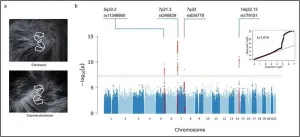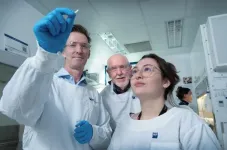(Press-News.org) PHILADELPHIA – The transfer of a neurotransmitter from one type of skin cell to another (melanocytes to keratinocytes) altered electrical activity and promoted melanoma initiation in preclinical models, according to results published in Cancer Discovery, a journal of the American Association for Cancer Research.
Melanoma is a deadly form of skin cancer that develops in melanin-containing skin cells known as melanocytes. An intrinsic feature of melanocytes is their ability to secrete melanin-containing vesicles to surrounding skin cells called keratinocytes to give skin its color.
While approximately half of all melanomas harbor mutations in the BRAF gene, these mutations are present in many benign skin lesions as well.
“This suggests that BRAF mutation is not sufficient for melanoma development and raises the question of why certain BRAF-mutated melanocytes develop into cancer, while others remain benign,” said Richard White, MD, PhD, the senior author of the study and a physician-scientist at the University of Oxford Branch of the Ludwig Institute for Cancer Research and Memorial Sloan Kettering Cancer Center (MSK).
“Cancers exist within a community of cells from the onset,” added first author Mohita Tagore, PhD, a postdoctoral research scientist at MSK. “We were interested in understanding how the community of skin cells contributes to melanoma development.”
Since melanocytes are deeply embedded within a population of keratinocytes, White, Tagore, and colleagues asked whether communication between melanocytes and keratinocytes was involved in the progression of benign BRAF-mutated melanocytes into melanoma.
Using zebrafish, mouse, and human cell models, the researchers observed that the transfer of molecules between BRAF-mutated melanocytes and normal keratinocytes was critical to melanoma initiation and that it occurred almost exclusively between melanocytes and keratinocytes that were in direct contact with one another.
Researchers discovered that this communication was mediated by the neurotransmitter GABA, which was an unexpected finding given that GABA signaling is typically associated with neurons rather than skin cells, Tagore noted.
In neurons, GABA inhibits a neuron’s ability to send or receive electrical signals. The researchers observed a similar effect in skin cells, as the binding of secreted GABA to receptors on keratinocytes inhibited electrical activity in keratinocytes and led to the secretion of a tumor-promoting protein.
In addition, they found that melanoma cells had increased expression of genes involved in GABA production compared with non-malignant melanocytes.
The results suggest that BRAF-mutated melanocytes may upregulate and transmit GABA to dampen the electrical activity of neighboring keratinocytes, allow for vesicle transfer between the two cell types, and initiate the progression to melanoma, Tagore explained. She and colleagues hypothesize that molecules carried by vesicles from melanocytes to keratinocytes may trigger the secretion of the cancer-promoting protein from keratinocytes. Ongoing work is exploring this hypothesis.
“Something about normal electrical activity in keratinocytes appears to suppress the progression of BRAF-mutated melanocytes to melanoma,” she said. “Our findings indicate that some BRAF-mutated melanocytes are able to modulate this electrical activity through GABA in order to progress to melanoma.
“We typically consider electrical activity in the context of neuronal communication, but these observations implicate it in cancer development as well,” Tagore added.
“I would not have necessarily expected a neurotransmitter to be involved in the communication between skin cells,” said White. “Interactions between neurons and brain cancer cells have been reported, but here we observed neuronal-like communication occurring between two non-neuron cells.”
The findings may have therapeutic implications, as they raise the possibility of targeting GABA to treat or prevent melanoma, the authors said. However, they cautioned that additional research is needed to understand the study’s clinical applications.
A limitation of the study is that all experiments were performed in preclinical models. In addition, the findings may not apply to all melanomas due to the heterogeneity of the disease.
The study was supported by the National Institutes of Health, the Melanoma Research Alliance, the Debra and Leon Black Family Foundation, the Pershing Square Sohn Foundation, the Mark Foundation, the Alan and Sandra Gerry Metastasis Research Initiative at MSK, the American Cancer Society, the Harry J. Lloyd Foundation, Consano, the Starr Cancer Consortium, the Melanoma Research Foundation, the MSK TROT fellowship, the Marie-Josee Kravis Women in Science Endeavor Postdoctoral Fellowship, the Experimental Immuno-Oncology Scholars Fellowship, the Cancer Cell Map Initiative, and Ludwig Cancer Research.
White has received consulting fees from N-of-One, a subsidiary of Qiagen. Tagore declares no conflicts of interest.
END
Electrical signals between skin cells may influence melanoma initiation
2023-08-09
ELSE PRESS RELEASES FROM THIS DATE:
The voices of indigenous peoples and local communities as an important part of the climate fight
2023-08-09
Coinciding with the International Day of Indigenous Peoples, an ICTA-UAB study calls for indigenous peoples' in-depth knowledge of climate change to be considered.
Indigenous Peoples and local communities around the world have a rich and extensive general knowledge of climate change impacts and possible ways to adapt. This knowledge should be recognised by both science and climate policy.
This is the main conclusion of an international study led by the Institute of Environmental Science and Technology of the Universitat Autònoma de Barcelona (ICTA-UAB) which has spent five years analysing and providing detailed data on how Indigenous Peoples and local communities ...
Having a bad hair day? Blame your genes!
2023-08-09
Philadelphia, August 9, 2023 – The first gene mapping study on human scalp hair whorls not only shows that hair whorl direction has a genetic basis, but also that it is affected by multiple genes. Four associated genetic variants that are likely to influence hair whorl direction are identified, as reported in the Journal of Investigative Dermatology, published by Elsevier.
A hair whorl is a patch of hair growing in a circular pattern around a point specified by hair follicle orientations. As an easily observed human trait, scalp hair whorl pattern is typically defined by the whorl number (single ...
New survey confirms need for more menopause education in residency programs
2023-08-09
CLEVELAND, Ohio (August 9, 2023)—Despite the fact that nearly 90 million women in the United States are projected to be postmenopausal by 2060, menopause remains low on the priority list of many residency programs. A new survey reveals the lack of a standardized menopause curriculum and limited access to menopause educational resources for residents. Results of the survey are published online today in Menopause, the journal of The Menopause Society.
Because women today are living longer, it is not surprising that there are a record number of postmenopausal women. And, that number is only expected ...
Booster shot being developed to avoid recapturing koalas to fight Chlamydia disease
2023-08-09
A booster vaccine using implant technology for koalas is being developed by QUT researchers in the fight against the deadly Chlamydia disease.
The new technology is designed to avoid problems for wild koalas and wildlife handlers having to recapture or hold the animals for 30 days, to receive a second immunisation.
Koala chlamydia is a bacterial infection and is one of the leading causes of death for Australian koalas.
QUT researchers have been successfully testing a two-shot vaccine on an isolated wild koala colony ...
After 15 years, pulsar timing yields evidence of cosmic background gravitational waves
2023-08-09
The universe is humming with gravitational radiation — a very low-frequency rumble that rhythmically stretches and compresses spacetime and the matter embedded in it.
That is the conclusion of several groups of researchers from around the world who simultaneously published a slew of journal articles in June describing more than 15 years of observations of millisecond pulsars within our corner of the Milky Way galaxy. At least one group — the North American Nanohertz Observatory for Gravitational Waves (NANOGrav) collaboration — has found compelling ...
Grant provides cancer research training experience to expand workforce for cancer prevention and control
2023-08-09
University of Arizona Cancer Center researchers were awarded a $1.5 million grant from the National Cancer Institute to deliver an intensive, multidisciplinary cancer prevention and control research training program for undergraduate and graduate students.
According to multiple principal investigators Jennifer Bea, PhD, and Cynthia Thomson, PhD, RD, the goal of the 10-week, full-time summer program is to motivate students to pursue a career in cancer prevention science.
“I am very concerned about the number of skilled scientists and clinicians retiring,” said Dr. Bea, co-leader of the UArizona Cancer ...
World’s largest study shows the more you walk, the lower your risk of death, even if you walk fewer than 5,000 steps
2023-08-09
The number of steps you should walk every day to start seeing benefits to your health is lower than previously thought, according to the largest analysis to investigate this.
The study, published in the European Journal of Preventive Cardiology [1] today (Wednesday), found that walking at least 3967 steps a day started to reduce the risk of dying from any cause, and 2337 steps a day reduced the risk of dying from diseases of the heart and blood vessels (cardiovascular disease).
However, the new analysis of 226,889 people from 17 different studies around the world has shown that the more you walk, the greater the health benefits. ...
Theory meets practice
2023-08-09
(Santa Barbara, Calif.) — Scientific findings don’t always translate neatly into actions, especially in conservation and resource management. The disconnect can leave academics and practitioners disheartened and a bit frustrated.
“We want conservation science to be informing real-world needs,” said Darcy Bradley, a senior ocean scientist at The Nature Conservancy and a former director of UC Santa Barbara’s Environmental Markets Lab.
“Most managers and practitioners also want to incorporate science into their work,” ...
$4M NIH grant will test worksite sleep health coaching for Arizona firefighters
2023-08-09
A $4 million award from the National Heart, Lung, and Blood Institute, a division of the National Institutes of Health, will allow researchers in the University of Arizona Mel and Enid Zuckerman College of Public Health to identify key factors for the successful implementation of workplace sleep coaching to improve sleep health in Arizona firefighters.
Almost half of career firefighters report short sleep and poor sleep quality, and about 37% of firefighters screen positive for sleep disorders like sleep apnea, insomnia or ...
Chemical contamination on International Space Station is out of this world
2023-08-09
Concentrations of potentially harmful chemical compounds in dust collected from air filtration systems on the International Space Station (ISS) exceed those found in floor dust from many American homes, a new study reveals.
In the first study of its kind, scientists analysed a sample of dust from air filters within the ISS and found levels of organic contaminants which were higher than the median values found in US and Western European homes.
Publishing their results today in Environmental Science and Technology Letters, researchers from the University of Birmingham, UK, as ...





